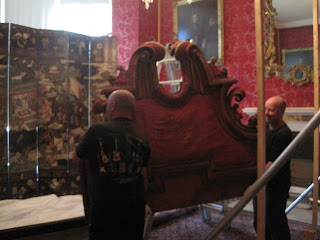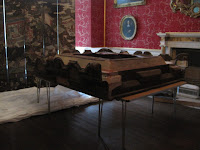5th place:
Alfred Edward Chalon, 1780-1860
Pastoral Evening

A pen, ink and watercolour drawing of a herd of cows being driven home and descending a hill as the sun sets. This picture was most likely a quick sketch or preparatory drawing, as it lacks the highly detailed finish that the Swiss born Chalon’s paintings tend to display. But this is why I like it. The legs of the roughly drawn cows look quite awkward, as if they are struggling to walk down the hill after a long day in the fields.
4th place:
Edward Dayes, 1763-1804

A stream, a bridge, a town in the background, a family, and some cows: this picture is an example of the delicate style of the skilled figure painter Edward Dayes. The intermingling of urban and rural imagery in this picture shows cows to be an inevitable part of the landscape in the 18th century in both town and countryside. The cows paddle in the stream as one stares at its own reflection in the water.
3rd place:
William Chapman, 1817-1879
A View of York
Here again, cows can be seen as an intrinsic feature of the urban/rural landscape. Chapman uses a rich pinky-red as the sun descends over York, and the cows huddle together in the foreground by a broken fence. A love of the strawberry roan colour of cows contributed to the desire of artists such as Chapman and David Cox to frequently depict these animals in their works.
2nd place:
William Estall, 1857-1897
Estall uses bright colours and expressive brush-strokes in this picture of a wooded scene with houses in the background, a stream, a paddling of ducks and two cows. This painting is one of my favourites as I feel the cows are not just simply part of the scenery, but have been imbued with personality! The cows stand by the river, looking at each other, as if deep in conversation or perhaps in the middle of a staring competition..
1st place:
George Chinnery, 1774-1852

My top cow picture is this work by George Chinnery. This was the first picture at the gallery that I fell in love with, and that ultimately inspired the top 5! Here, the cows go for a day at the beach, some paddle whilst others choose to sunbathe. The atmosphere is serene, and Chinnery’s use of light and shade plays homage to his skill as a watercolour artist.
So, cattle have proved to be popular subject matter for 18th and 19th Century watercolour artists and were, and indeed still are, common and beautiful features of the Great British landscape. The inclusion of these animals in paintings and drawings seems to automatically add a sense of serenity and an uplifting mood to the work perhaps by conjuring for the viewer the slow pace of life that cows enjoy!
Indeed, this view of cows as peaceful, uplifting animals, is one shared by the organisers of CowParade: the world’s largest public art event. CowParade has raised millions for charities and donated to artist communities over the years by staging events in over 50 cities worldwide. Life-size fiberglass cows created by artists, designers, architects and each sporting different patterns, designs and themes, are dotted around the city for all to see and touch.
CowParade’s reasoning behind using models of cattle specifically, includes the fact that the cow is an animal that receives ‘universal affection, representing different things to different people around the world’ from being a sacred or historical animal, to being a purely familiar and beloved creature. CowParade has visited cities all over the world including Florence, Johannesburg, London and Manchester, but it has yet to come to Leeds.
If you want to learn more about CowParade, follow this link to their website:
http://cowparade.com/
I hope you have enjoyed my top 5 and that it has showcased a handful of the beautiful watercolours and drawings that make up the Leeds collection.

 The bed was dismantled piece by piece and is now ready for the necessary structural and conservation works.
The bed was dismantled piece by piece and is now ready for the necessary structural and conservation works. Then the rest of the bed was removed from under the canopy starting with the headboard.
Then the rest of the bed was removed from under the canopy starting with the headboard.










